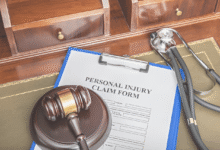How to Claim Personal Injury Damages in South Australia
Personal injury claims South Australia Learn how to claim compensation for accidents, workplace injuries & negligence. Get expert legal advice.

Personal injury damages in South Australia provide a legal pathway for individuals to seek compensation when harmed due to another party’s negligence. Whether the injury stems from a car accident, workplace incident, medical malpractice, or a public slip-and-fall, understanding your rights is crucial. South Australian laws, including the Civil Liability Act 1936 and Workers Rehabilitation and Compensation Act 1986, outline how victims can pursue financial recovery for medical bills, lost wages, and pain and suffering. However, the claims process can be complex, requiring timely action and proper documentation to maximize your chances of success.
Navigating a personal injury claim involves multiple steps from gathering evidence and filing paperwork to negotiating with insurers or even going to court. Many victims face challenges such as disputed liability, low settlement offers, or strict time limits that can jeopardize their case. This guide will break down the essential aspects of claiming personal injury damages in South Australia, helping you understand eligibility, compensation types, and legal strategies to secure the best possible outcome. Whether you’re just starting or facing hurdles in your claim, knowing the right approach can make all the difference.
How to Claim Personal Injury Damages in South Australia
Understanding Personal Injury Claims in South Australia
A personal injury claim allows an injured party to seek financial compensation for harm caused by another’s negligence or wrongful act. In South Australia, these claims are governed by various laws, including the Civil Liability Act 1936 and the Workers Rehabilitation and Compensation Act 1986, depending on the nature of the injury. To succeed in a claim, you must prove that the other party owed you a duty of care, breached that duty, and caused your injury. Common scenarios include road accidents, slip-and-fall incidents, workplace injuries, and medical negligence.
Types of Personal Injury Damages You Can Claim
Economic Damages
These cover provable monetary losses like medical bills, rehabilitation costs, lost wages, and future earning capacity. Receipts, payslips, and expert reports help quantify these claims.
Non-Economic Damages
Compensation for physical/emotional harm including chronic pain, trauma, and reduced quality of life. Severity and long-term impact determine payout amounts.
Special Damages
Reimbursement for incidental costs like travel to medical appointments, home care, or damaged property. Requires detailed record-keeping of all expenses.
Exemplary Damages
Rare punitive compensation in extreme cases of negligence/malice (e.g., drunk driving accidents). Courts award these to deter similar misconduct.
Dependency Claims
For families of deceased victims, covering funeral costs and lost financial support. Spouses/children may claim loss of companionship.
Steps to File a Personal Injury Damages
Seek Immediate Medical Attention
Prioritize your health and obtain official Medical record documenting your injuries. These serve as crucial evidence linking your condition to the accident.
Report the Incident Properly
File reports with relevant authorities police for accidents, employers for workplace injuries, or property owners for slip-and-fall cases. Get official documentation copies.
Gather Comprehensive Evidence
Collect photos/videos of the scene, witness contacts, damaged property, and keep all receipts for injury-related expenses. Maintain a pain/symptom diary.
Consult a Personal Injury Lawyer
Engage a specialist attorney to evaluate claim viability, calculate Personal Injury Damages , and handle communications with insurers/opposing parties.
Lodge Your Formal Claim
Submit claim documents to appropriate entities (CTP insurer for car accidents, ReturnToWorkSA for workplace injuries) before statutory deadlines.
Negotiate Settlement Offers
Your lawyer will review insurer proposals, counter lowball offers, and negotiate for fair compensation covering all your losses.
Prepare for Potential Litigation
If settlement fails, your lawyer will file court proceedings and represent you through hearings, mediation, and potential trial.
Finalize Settlement or Judgment
Upon successful resolution, ensure all compensation terms are properly documented and paid before closing your case.
Time Limits for Filing a Claim
General Personal Injury Claims (3-Year Limit)
Most Personal Injury Damages claims must be filed within 3 years from the accident date under the Limitation of Actions Act 1936. This applies to slips/falls, assaults, and other negligence cases.
Motor Vehicle Accidents (6-Month Notice)
For CTP (Compulsory Third Party) claims, you must notify the insurer within 6 months of the crash. While exceptions exist, late filings risk claim denial.
Workers’ Compensation (1-Year Deadline)
Work-related injury claims must be lodged with ReturnToWorkSA within 12 months of the incident or symptom onset (for gradual injuries).
Medical Negligence (3 Years with Exceptions)
Malpractice claims also follow the 3-year rule, but courts may extend this if the injury wasn’t immediately discoverable (e.g., surgical errors).
Common Challenges in Personal Injury Damages
Disputed Liability
Insurance companies often challenge who was at fault to reduce payouts. Strong evidence like witness statements and accident reports is crucial to prove negligence.
Inadequate Settlement Offers
Insurers frequently make lowball offers hoping claimants will accept. Having a lawyer ensures proper valuation of your claim for fair compensation.
Pre-Existing Conditions
Defendants may blame your injuries on prior health issues. Medical experts can distinguish between old and new injuries to protect your claim.
Statute of Limitations Issues
Missing filing deadlines (3 years for most claims) can void your case. Immediate legal action preserves your right to compensation.
Insufficient Evidence
Weak documentation hurts claims. Thorough evidence collection including photos, medical records and expense receipts strengthens your position.
Complex Legal Procedures
Paperwork errors or missed court dates can derail cases. An experienced lawyer navigates the legal system efficiently on your behalf.
Pressure to Settle Quickly
Insurers may rush you to accept fast, unfair settlements. Patience and legal guidance often lead to significantly better outcomes.
Why You Need a Personal Injury Lawyer
Expert Case Evaluation
A Personal Injury Damages lawyer assesses your claim’s true value, identifying all compensable Personal Injury Damages insurers often overlook. They develop a winning legal strategy tailored to your specific circumstances.
Handling Complex Paperwork
Attorneys manage all legal filings, insurance forms, and court documents with precision, ensuring strict compliance with South Australia’s claim procedures and time limits.
Powerful Evidence Collection
Lawyers utilize professional networks to gather police reports, medical records, accident reconstruction analyses, and expert testimonies that strengthen your case significantly.
Skilled Negotiation With Insurers
Experienced lawyers know insurance tactics and counter lowball offers effectively, often securing settlements 3-5 times higher than unrepresented claimants receive.
Courtroom Litigation Expertise
If settlement fails, your attorney becomes a fierce advocate in court, presenting compelling arguments and examining witnesses to maximize your compensation at trial.
Contingency Fee Advantage
Most Personal Injury Damages lawyers work on “no win-no fee” basis, removing financial risk – you only pay if they successfully recover compensation for you.
Read More: How to Navigate NHS Healthcare Disputes: UK Legal Solutions
Conclusion
Successfully claiming Personal Injury Damages in South Australia requires prompt action, thorough documentation, and a clear understanding of your legal rights. From seeking immediate medical attention to gathering crucial evidence and negotiating with insurers, each step plays a vital role in building a strong case. While the process may seem daunting, being informed about time limits, compensation types, and potential legal challenges can significantly improve your chances of securing fair compensation for your injuries and losses.
If you’ve suffered harm due to someone else’s negligence, don’t delay in seeking professional legal advice. An experienced Personal Injury Damages can guide you through the complexities of your claim, handle negotiations with insurers, and ensure you receive the maximum Personal Injury Damages you’re entitled to. Remember, the sooner you take action, the stronger your case will be protect your rights and focus on recovery while your legal team fights for the justice and compensation you deserve.
FAQs
What types of injuries qualify for compensation?
You can claim Personal Injury Damages for physical/psychological harm from accidents, workplace injuries, medical negligence, or public liability incidents.
How long do I have to file a claim?
Most claims must start within 3 years, but motor accident claims require CTP notification within 6 months in South Australia.
What compensation can I receive?
Successful claims may cover medical bills, lost income, rehabilitation costs, pain and suffering, and future care expenses.
What if I’m partly at fault for the accident?
You can still claim under contributory negligence rules, but your payout may be reduced based on your responsibility percentage.
Do I need a lawyer for my injury claim?
While not mandatory, a personal injury lawyer dramatically improves success rates by handling evidence, negotiations, and potential court proceedings.











